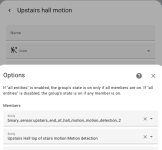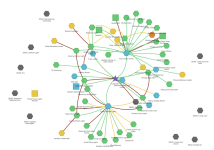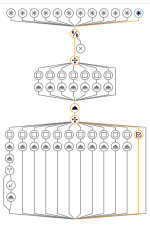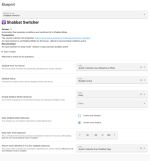My house uses Insteon with Indigo (Mac) as the controller. Also have hue bulbs which aren't (yet) integrated in.
You are using an out of date browser. It may not display this or other websites correctly.
You should upgrade or use an alternative browser.
You should upgrade or use an alternative browser.
Smart Home Automation
- Thread starter ChaoticUnreal
- Start date
- Status
- You're currently viewing only Scotttheking's posts. Click here to go back to viewing the entire thread.
OK, light bulbs, I'm thinking Sengled or Lifx. Anyone have experience with either? Or other, preferably moderate cost RGBW bulbs? Needs to play well with https://www.home-assistant.io as that's what I'm planning on using.
While this is from a year ago, the chart with lumens/etc I expect to be largely accurate. The Lifx and Sengled both seem pretty good in terms of lumen/control, although Lifx has a much wider color temp they claim to be able to reproduce which is nice.
I'm OK with zigbee stuff as well, there's a variety of HA zigbee/zigbee2mqtt hardware/hacks out there for me to try.
I figure I'll start with 1 bulb, get it integrated and working, and then move on from there.
I think I must be weird, or losing my geek credentials, but I just don't get this RGBW home automation stuff. Don't get me wrong, I like lights, I have lots of them in my house, but for the most part they're plain old white LEDs that can be on or off - I'm an IT guy, I like binary. There are a few dimmer switches left in the place but only because I haven't got round to replacing them.
I feel like I'd play around with such things for a day or two and then never change their settings (from white on/off) ever again. What do you true aficionados do with them?
I use a mix of white and RGB bulbs. Color helps - red light is easy to sleep through so makes a good night light, going to bed lights is a soft red shift, etc. The hallway, however, is a white bulb.
Going nuts on thermostats and hvac in general. Contractor uses Daikin and it seems their public APIs are via their remote servers only. I don’t want anything internet connected. But I do want air quality sensors able to activate ventilation systems. Anyone found good local api compatible solutions?
I'm interested in that too. We've got a Daikin minisplit in our mother in law apartment and it'd be nice to have remote control over it when we're between tenants, like right now, or if we decide to go the Air-BnB route. It's a small unit and the thermostat doubles as handheld remote control. I haven't thought about it very long, but my initial thoughts think the easiest hack would be mounting a little wi-fi connected microcontroller with IR capability.
Daikin has wifi modules for much of their lines, depending on how old your model is. If you don't care that wifi means connect to their cloud service for control.
I’m going to get this sensor just to mess with guests… https://www.fibaro.com/en/products/motion-sensor/
While I get around to making the thread, new house is 50-75 zwave devices, pretty sure just broke 50 Hue lights, and some other components. Working on setting up home assistant. I will make the thread!
I'm terribly slowly plugging away at my setup but have put the base Home Assistant automations in github. Once I make a functional readme it'll get linked.
Nah, if they take off it’ll integrate in to the controller and you can switch devices as they fail. Nice thing about the major HA controllers is they don’t care what protocols they are talking, it is just another plugin.I'd avoid Z-wave these days unless you have immediate need. AFAIK the aim of Thread/Matter is going to be deprecating it and everyone will move over to that. It'll take a bit of time of course, for existing/future products to be migrated over, but I feel Z-wave and Zigbee are the past, and shortly to become relatively completely deprecated for new devices.
What are you trying to solve?They look to be. They have Zigbee and Z-wave certified options, and work with Homekit and IFTTT, as well as Smartthings and schlage. But as I have no intention of interacting with it other than with wired devices and pre-set timers, and don't care if it plays nice with others, I'm open to a mostly closed platform as long as it works (given Leviton is a large enough company that they are unlikely to go anywhere, and if all I need are switches talking to each other, I may be OK even if they EoL my crap, unless it's cloud mediated bullshit, which is why I'm asking)
Have you got a suggestion for an alternative switch vendor? I don't really want fancy, I want reliable basic functions with only a little bit of smarts. TBH, if I were building this from the ground up, I'd probably just do it all with PLC hardware because it's what I know and am comfortable with. But the house already exists.
EDIT: Leviton's brochure doesn't mention Matter. Their amazon listing does. IDK? The amazon listing implies that their Matter functionality is early access.
As a basic switch, they are fine. If you want to do smarts, you need a hub of some kind, which could be a piece of software and a dongle running on a computer. Search for zwave, or zigbee hubs.
If you don't want (smart) switches, you could look at something like these: https://www.getzooz.com/smart-relays/
Most of my house is Zwave, and most of my devices are Zooz.
If you wanted to go "simpler", maybe look at TP-Link Kasa, their devices are wifi.
How are you programming them?I got their wifi connected Decora smart Gen 2 switches, which apparently do now support Matter with a firmware update, and don't need a hub if you have a neutral, so I think I'm OK.
Edit: digging, they must have a microcontroller on each switch. Sounds good for your needs.
Last edited:
Random stats:
Current device count in home assistant: 141
Current entity count in home assistant: 1136
Current device count in home assistant: 141
Current entity count in home assistant: 1136
Get a pile of sensors and your count will spike.I’m at 117 and 395 myself. I must need to add some more abstraction layers.
Goal: to have my house “finished” and documented by the end of the summer.
Never finished, but right now it is very MVP class, HA wouldn’t come back after power failure, automations are scattershot, bunch of uglies. There are even switches that don’t work (need to build virtual 3 ways), etc.Finished do you really believe you will ever be finished?
And I’m impressed. My documentation of my home is a mess.
Documentation is for, well, you’ll see.
My entire zwave setup stopped working late morning today (fixed by resetting this evening)...I know pretty much the exact time, now to see how miserable hunting HAs logs are...
Finally making some progress with documenting my house setup. Would a person or two who is familiar with HA be willing to review and suggest improvements to the docs? Would like to have it followable before sharing publicly.
Getting ready to send my first issue to HA for a an integration. New device (hvac controller) uses an old version of an api and exposes fields that it doesn’t use, and those fields are what the integration chooses over the in use field. I expect they’ll need to add specific device detection to their code. If this is the issue, once fixed my hvac will be properly plugged in to HA. Hopefully they’ll do it!
Last edited:
I'm...attempting to figure my way through python and the repo structure.Yippee!
Are you handy with code? If so, you probably could do it and contribute a PR to fix it
Not certain because it’s going to have to validate numbers to correct for the hw bug, possibly a new function. without a HA dev instance I can’t build and test it, sadly. Early 2025 goal is said dev instance.Ah, good luck. Probably can hop on the discord and get some decent pointers on where to start/structure.
Finally switched HA from zwavejs to zwavejsui. Now I can set direct associations to (finally) configure 3 way switches.
Of course, first have to fix every device that joined at wrong security level…
But it’ll be very nice for all the switches to be working…
So far moved one pair from a helper and two automations to direct association!
Of course, first have to fix every device that joined at wrong security level…
But it’ll be very nice for all the switches to be working…
So far moved one pair from a helper and two automations to direct association!
Yeah that’s certainly an advantage of rewiring the house. I cheaped out and didn’t put smart switches in the closets…regretting that because it defeats an “all off” button.Three-way* smart switches have generally defeated me in my house. No neutral and some poor labeling of travelers.
*four- and five-.
Currently debating direct association vs. HA device groups and when to choose one or the other. simplicity and performance vs. visibility and flexibility seem to be the core factors.
Yep Zwave controls (pretty sure zibgee is same) - direct association where devices are directly communicating with each other, not going through HA. The basic, 3 way switch example - wires are connected to switch A. When switch B is turned on, (also) turn on switch A. When switch A is turned on, (also) turn on switch B.@Scotttheking you're referring to Zigbee/ZWave controls?
I was using old style Groups, I need to redo those to be the newer Groups, so that I can use the Voice PE to start controlling things.
It's Groups from zwave-js-ui.

Vs. joining the switches in HA via a helper:

Pros of direct association:

After tinkering with it I'm going to limit direct association to pysical switches to make a 3+ way switch, anything more complicated, including the motion sensor switches, stay in HA, with the possible exception of one room.
Half of the motion switches aren't connected to load, I grab the motion data in HA with a sensor group and use that to activate. After use, I think ideally none of the motion switches would be on load due to the Zooz switches having more flexible settings.
More tinkering tomorrow!
The Zwave network map is cool.

- nearly instant
- No dependencies on external hardware/services (doesn't need HA)
- Less load on the controller (although mine's a M4 Mac Mini - it'd better have enough oomph)
- Way less flexible - can't govern execution with rules
- Opaque - rather than looking at the list of automations, one has to look at each device and what it's linked to
- Each switch clicks as they turn each other on
After tinkering with it I'm going to limit direct association to pysical switches to make a 3+ way switch, anything more complicated, including the motion sensor switches, stay in HA, with the possible exception of one room.
Half of the motion switches aren't connected to load, I grab the motion data in HA with a sensor group and use that to activate. After use, I think ideally none of the motion switches would be on load due to the Zooz switches having more flexible settings.
More tinkering tomorrow!
The Zwave network map is cool.

Works the same or similar in all of them: Device A directly activates Device B, automation system can also call devices via rules (automations).So for my Insteon, the Direct Association just works and I can't control that particular link (it's called linking in Insteon) through automations, but I can still control the switch/light as a group through rules (i.e. lights turn off at 11pm, etc). Can I not do that with Z-wave? I haven't tried.
The specific situation that triggered my musing is that I have a pair of motion switches that form a 3 way setup for hallway lights.
With direct association, if either motion sensor triggers, it turns on the light, either directly or by calling the other switch. Excellent, it just works™.
With it running through HA, I had something more complex set up - the switches were configured for manual on/off, the motion sensor entities were captured as a motion sensor group, and that triggered an automation which turn the light on or off. The cons is, without HA the lights don't turn on. The reason for doing it that way is allowing for conditionals in the automation - if after 7pm call lights at dim, if kids' door is open lock out the lights so the on/off doesn't wake them up, etc.
An option could be leave direct association on, but at 7pm or whatever reconfigure the switches to manual instead of occupancy and run via the automation. But that's an annoying UX because the lights are controlled differently at different times.
Finally made a working motion sensor lockout. It’s too complex, imo, consisting of:
automation for the scene controller
automation for lights on/off
a helper toggle for motion lockout
a sensor group for the pair of motion sensors
A small button on zen32 scene controller toggles the lockout and the large button provides manual light control. Hmm, maybe I should set a direct association for that big button for HA down solution…thinks
automation for the scene controller
automation for lights on/off
a helper toggle for motion lockout
a sensor group for the pair of motion sensors
A small button on zen32 scene controller toggles the lockout and the large button provides manual light control. Hmm, maybe I should set a direct association for that big button for HA down solution…thinks
Woah, that’s great, thanks! I’ll try moving over to it this weekend as it has features I want but didn’t write yet.I used to have this all done through a custom AppDaemon python app I wrote. I've moved it all to this Sensor Light blueprint and it's working very well! It lets you set a helper toggle like you've done for overrides. It's still the same number of items as you've got (two automations, a helper, and a sensor group) but I think with the blueprint it's much easier for someone else to understand it if they need to.
Switched over to it, looking good!Woah, that’s great, thanks! I’ll try moving over to it this weekend as it has features I want but didn’t write yet.
I’m having a heck of a time using my zwave dimmer to control brightness of hue bulbs. Will post some code.
I’m also embarrassed to admit that most of my hue bulbs aren’t connected to the hubs and are on/off white from a normal switch.
I’m also embarrassed to admit that most of my hue bulbs aren’t connected to the hubs and are on/off white from a normal switch.
The horrible solution to this?Debugging blueprints is terribly painful.
Getting error when deploying blueprint to automation. Spent a while last night trying to fix this, no luck yet.
View attachment 102877
Spent the past couple days implementing as an automation so that I can actually test everything before moving to blueprint phase. Needed a bunch of helpers to put the conditionals in that will be blueprint fields.
Just a touch of conditional logic here...

It works but is more effort.I've run it in a docker forever with no issues. I just don't get the "addons" which are just docker containers that HA manages so those are easy enough to add myself.
I don’t think we are disagreeing.Not really. If you're used to using docker, which presumably you are if you're running HA in docker, it's dead simple to add anything else that's containerized. And you get the control of doing it yourself. I run tons of different services via docker, and I need to be able to manage them myself, not let HA do whatever it thinks is right. I have different networks to segregate services. Some can reach the internet, some can reach my IoT devices, some can't reach shit. I have different paths mounted to different containers. I manage backups if each automatically via zfs snapshots. I share hardware like GPUs across multiple containers.
If HA stopped releasing docker images, I'd containerize it myself (or I'm sure linuxserver would have an image, if they don't already). I don't have a reason to ever go back to VMs.
No worries, not trying to spark one either. What I'm hearing from you is paraphrased "if you already run docker infra it's no big deal" and I agree with that. Getting to that point vs. the HASS VM, I'd argue is more work.I don't think it's really more effort. If you just want to use it off the shelf, with no customizations (all you can do from the "add-on store"), then it's open your docker-compose.yaml, copy and paste a block, rename the service to whatever you want to call it, and change the image name to whatever image you want to run. That might take me two minutes vs one minute digging through the add-on store thing or likely the same amount of time if I have to go add the repo manually anyway, but is it more effort? No, I don't think so.
If you want to do anything outside of "run this image as it comes", then it's much less effort to manage the containers yourself. I don't think you can even modify anything about the containers running as add-ons, can you?
Here's an example. I use Frigate, which I know is available as an add-on. I also know add-ons can't use the Nvidia runtime, so no GPU decode like I'm using. And can you even mount USB or PCIe devices into the container? Because the whole point of Frigate is to use AI classifiers accelerated by cheap AI accelerators like the Coral. I also don't believe you have any way of defining a mount point for your video, so I can't mount the path for my NVR to the frigate container. How does that work? It uses the media path common to all other services installed by HA? I also have my cams on a segregated subnet that keeps them away from everything, even my other IoT devices. But I don't route all that traffic across VLANs. I mean I could, but then that's unnecessary traffic to and from the router and the camera feeds would go down while updating the router. Instead, my frigate container has an interface on the camera VLAN and also in the IoT subnet with HA. I know you definitely can't to any fancy networking with add-ons.
E: sorry, I didn't mean to start an argument. It's been a long, long day.
Oh hey, missing a section header, that'll do it...Debugging blueprints is terribly painful.
Getting error when deploying blueprint to automation. Spent a while last night trying to fix this, no luck yet.
View attachment 102877
Assuming you mean thermostat, that’s easy - look for a remote temperature sensor.Is there a "smart" thermometer, preferably Home Assistant compatible, that can use the temperature of sensors instead of itself? The thermostat in this house is just a sheet of drywall (and maybe a sheet of aluminum ductwork) away from the air return, which runs down the wall directly behind it. This makes the thermostat read 3º F cooler than the rest of the main floor. The problem is once the sun stops heating things up and the rest of the house cools down, it would get too cold if I left it 3º colder than I want it. So I want a thermostat that can ignore its own readings and only use those of remote sensors. Does such a thing exist?
(It's a rental, so I'm not going to think about relocating the thermostat or doing anything with the A/C unit otherwise.)
The thermostat I use is a Venstar, look at Explorer, Explorer IAQ, or ColorTouch lines that have wifi: https://venstar.com/
Then add either https://venstar.com/thermostats/accessories/wifi-temperature-sensor/ or https://venstar.com/thermostats/accessories/remote-sensor-10k/ or if IAQ https://venstar.com/thermostats/accessories/vennet-temp-hum-sensor/ and set the thermostat to use that for temperature readings. Works great via local API with HA.
Could also rig something up with HA to adjust the thermostat set point based on the difference between thermostat and remote.
Depends on how you want to go.Anyone got a recommendation of a smart smoke/CO detector that will talk to the thermostat and shut off the furnace if CO is detected? Looks like my previous solution has entered the next circle of its death spiral. Which sucks because I didn't buy into the Google ecosystem for exactly this reason. But that didn't stop them from buying into my house and killing my hardware
More self contained - get a CO detector that has a relay and use that to open/close the shut off contacts on your furnace. Or trap that signal with a smart relay and use it to send a command to the thermostat. My thermostat has a pair of contacts that can be used directly for this function even (Venstar Explorer IAQ).
Zwave alarm signal sensor: https://www.thesmartesthouse.com/products/zooz-800-series-z-wave-long-range-dc-signal-sensor
Random link, kiddie interface module: https://www.supplyhouse.com/Kidde-CO120X-CO120X-Carbon-Monoxide-Alarm-Relay-Module
Another: https://www.mtiindustries.com/product/plug-in-carbon-monoxide-alarm-with-relay/?gQT=1
Last edited:
Todo: write an air quality management blueprint. Figuring out the triggers may be the hardest part because considering multiple variables in concert - linear algebra triggers!
- Status
- You're currently viewing only Scotttheking's posts. Click here to go back to viewing the entire thread.




